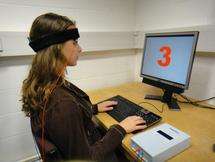Synaesthesia linked to a hyper-excitable brain

(Medical Xpress) -- ‘Hyper-excitability’ in regions of the brain may underlie synaesthesia, an unusual condition where some people experience a ‘blending of the senses’, Oxford University researchers suggest.
The neuroscientists used some of the latest brain stimulation techniques with people who ‘see’ colours when reading numbers or words, a common form of the condition called ‘grapheme-color synaesthesia’.
They investigated activity in the visual-processing part of their brain, and compared it against the brain activity seen in a control group of people without synaesthesia.
They found that people with this type of synaesthesia had a higher level of ‘excitability’ in their primary visual cortex. It took much less stimulation for neurons in this part of the brain to fire.
The researchers also showed that changing the excitability, making it harder or easier for the neurons to fire, could increase or lessen the effects of the synaesthesia.
"The hyperexcitability of the visual area may underlie synaesthesia in people who experience colours triggered by words or numbers," says Dr. Devin Terhune, first author on the Oxford University study. "This new finding challenges previous theories to explain the condition. The magnitude of the difference is extremely large. This is a fundamental difference in the brains of synaesthetes that may relate to the development of their synaesthesia," he adds.
The study is published in the journal Current Biology and was funded by the Wellcome Trust and the Cogito Foundation.
People experience synaesthesia in a variety of ways. Some people may ‘see’ sounds, in that hearing sounds triggers them to see particular colours at the same time. Others might experience colours while reading simple black text. Some estimates suggest that synaesthesia affects perhaps as much as 4% of the population.
This ‘blending of the senses’ is automatic and involuntary. Whether it is a sound, or number, or taste that triggers the experience of another sense, the connections are always the same. In the case of grapheme-colour synaesthesia, particular letters, numbers or words will always stimulate precisely the same colors.
"We tend to assume that we experience the world in the same way as everyone else. Synaesthesia is a compelling example of how some people perceive the world in a fundamentally different way," says Dr. Terhune.
Dr. Roi Cohen Kadosh of the Department of Experimental Psychology at Oxford University, who headed the research group, added: "Studying synaesthesia can tell us about how the brain develops, how perceptions and cognitions become automatic. It gives us an insight into the brain processes underlying conscious awareness."
The research team used two brain stimulation techniques that are non-invasive, using devices placed on the outside of the head to apply either very weak magnetic fields or tiny electric currents to specific parts of the brain. They are research tools, known to be safe, and designed to be just strong enough to temporarily influence neural activity in that part of the brain and see what effect this has on brain processes.
The first test used transcranial magnetic stimulation (TMS), in which a weak magnetic field was used to stimulate neurons to fire in the main visual-processing region of the brain, the primary visual cortex.
The researchers measured the stimulation necessary for the study volunteers to experience streaks of light in their vision, much like the after-images seen after looking at a bright light.
Every person has a different threshold necessary for neurons to fire. But the five people in the study with grapheme-colour synaesthesia only needed tiny amounts of stimulation in comparison to those without synaesthesia.
This result was only found in the visual area of the brain. The same test on the volunteers’ motor cortex showed no differences between those with synaesthesia and the control group.
"This propensity for the neurons to fire in the visual area of the brain shows this region may be more sensitive, more excitable in those with this form of synaesthesia," explains Dr. Terhune.
The researchers then used a second technique called transcranial direct current stimulation (TDCS) to see whether this hyperexcitability was related to the experience of synaesthesia in the five volunteers.
The approach applies a very small electric current across regions of the brain to change the threshold for neurons to fire. Applying the current in one direction makes it harder for them to fire, while applying it in the other direction makes it easier.
The researchers found that turning the excitability up or down in the primary visual cortex led the five synaesthetes to have a stronger experience of colours connected with words or numbers, or would diminish or eliminate it entirely.
"It may be that we become aware of things because our neurons pass a certain threshold. In synaesthesia this appears to be the case. With a lower threshold for hyperexcitable neurons, it’s easier for neurons to fire and this accesses the conscious experience of color," says Dr. Cohen Kadosh.














